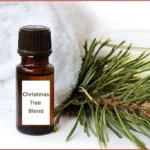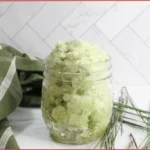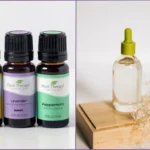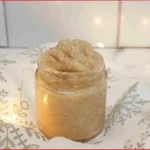This easy-to-follow homemade deodorant recipe will show you how to create a gentle, nourishing deodorant cream using natural ingredients, with the added bonus of essential oils for fragrance and skin benefits.

✨ Get 12 Free Holiday Diffuser Blends — Printable PDF
Instantly make your home smell like Christmas with these festive, ready-to-use recipes.
Switching to a natural deodorant is one of the best things you can do for your skin. Unlike sprays or sticks, this homemade deodorant cream is rich and moisturizing. It nourishes your skin while keeping odor at bay.
The best part? This natural deodorant recipe is completely customizable to your scent preferences.
Let’s get started!
Table of Contents
Affiliate Disclosure: Some links on this site are affiliate links. I may earn a small commission if you purchase through them, at no extra cost to you. See the full affiliate disclosure.
What Makes This Homemade Deodorant Recipe Special?
There are plenty of reasons to make the switch to a DIY deodorant cream.
Gentle on Skin: Ideal for those with sensitive skin or allergies to harsh chemicals found in traditional deodorants. This homemade deodorant recipe uses only natural ingredients known for their skin-friendly benefits.
Customizable Scent: With this natural deodorant recipe, you can create a fragrance that suits your mood or needs. Prefer a floral scent? Add lavender, rose or jasmine essential oil. Want something fresh and citrusy? A few drops of lemon or bergamot essential oil will do the trick. You can also tweak the ingredients to suit your skin’s sensitivity.
Skin-Nourishing Ingredients: Coconut oil and shea butter provide deep hydration, making this perfect for dry or irritated skin.
Cost-Effective: You can make high-quality deodorant at home for a fraction of the price.
Eco-Friendly: Store the cream in a reusable jar, cutting down on single-use packaging.
Most importantly, this deodorant actually works. The combination of arrowroot powder and baking soda helps absorb moisture and neutralize odor, while coconut oil and shea butter keep your underarms soft and nourished.
Homemade Deodorant Cream Ingredients & Benefits of Each

This simple recipe uses all natural skin-friendly ingredients. Each of these ingredients works together to keep your skin hydrated while making the deodorant easy to apply. They form the “base” of your recipe, ensuring it’s as nourishing as it is effective.
2 tablespoons Solid Coconut Oil: Naturally antibacterial and antifungal, coconut oil helps fight odor-causing bacteria while keeping the skin moisturized and soft. Coconut oil also acts as a carrier oil for essential oils.
2 tablespoons Shea Butter: A deeply nourishing ingredient that soothes and hydrates the skin. It helps prevent irritation, making the deodorant gentle enough for daily use.
2 tablespoons Arrowroot Powder: Absorbs excess moisture, keeping your underarms dry without blocking sweat glands. It also gives the deodorant a smooth, creamy texture.
1 tablespoon Baking Soda: A natural odor neutralizer that helps keep underarms fresh. If you have sensitive skin, you may want to use it in moderation or replace it with a gentler alternative.
10–15 drops Essential Oils (optional): Not just for fragrance! Many essential oils have antibacterial properties that enhance the deodorant’s effectiveness. Tea tree, lavender, and citrus oils are popular choices for freshness and odor control.
Note: This homemade deodorant recipe uses solid coconut oil. Liquid coconut oil will make the deodorant cream too runny and difficult to set.
How To Make Natural Deodorant Cream: Step-by-Step Instructions
Follow these steps to whip up your homemade deodorant cream in just minutes:
Step 1: Melt the Base Ingredients

Combine coconut oil and shea butter in a double boiler. Stir occasionally and gently to ensure even melting.
Heat gently until fully melted and smooth. Do not be tempted to rush the process. Melting coconut oil and shea butter on high heat damages their natural properties.
Melting gently on low heat is key to experiencing the skin-friendly benefits of the ingredients.
Step 2: Mix in Dry Ingredients

Remove the double boiler from the heat and stir in arrowroot powder and baking soda.
Whisk gently until the mixture is fully combined and lump-free.
Step 3: Add Essential Oils

Allow the mixture to cool slightly and add your choice of essential oils.
It’s important to wait until the mixture is sufficiently cooled down before adding essential oils to preserve their potency. Heat damages the properties of essential oils.
Stir well to evenly distribute the fragrance.
Step 4: Pour and Cool
Pour the mixture into a small jar or container while it is still warm. This homemade deodorant cream sets at room temperature and will become difficult to transfer.
Let it set at room temperature or place it in the fridge for faster cooling until it solidifies.
That’s it! Your deodorant is ready to use!
How to Use DIY Deodorant Cream

Using this deodorant is simple and fuss-free:
Use clean fingers to scoop a small pea-sized amount of the cream. Better still, use a clean wooden popsicle stick to minimize the risk of contamination.
Remember, a little goes a long way!
Gently rub it into your underarms until absorbed. Since this is a cream-based deodorant, it won’t dry instantly like a store-bought stick, but it will blend smoothly into your skin.
For best results, apply to clean, dry skin. If you’re transitioning from an antiperspirant, give your body a week or two to adjust as it detoxifies from aluminum-based products.
Enjoy natural, chemical-free freshness all day.
Benefits of Essential Oils in this Natural Deodorant Recipe
Essential oils are not just for fragrance—they can also enhance your deodorant’s effectiveness:
Tea Tree: Antibacterial and antifungal, great for fighting odors.
Lavender: Soothing and calming, perfect for sensitive skin.
Peppermint: Offers a cooling effect during hot months.
Lemon or Sweet Orange: Fresh and energizing, ideal for daily use.
Choose one or more of these skin-friendly essential oils that work best for you. Use them individually or mix two or more for a custom blend.
Add these refreshing essential oils for summer diffuser blends to give your homemade deodorant cream a cool, revitalizing scent.
How to Customize the Basic Homemade Deodorant Recipe

For Sensitive Skin: Reduce or omit the baking soda and replace it with additional arrowroot powder or a small amount of bentonite clay. Use corn starch if you don’t have arrowroot powder
For a Firmer Texture: If you live in a warm climate and want a more solid consistency, add a teaspoon of beeswax to the melted coconut oil and shea butter.
For Longer Shelf Life: Add vitamin E oil for added skin nourishment and to prolong the life of the natural deodorant.
For Preferred Scent: Choose a single essential oil or choose from any of these essential oil blend recipes to suit your desired scent and effect.
Troubleshooting Common Issues
Even with a simple recipe, you might run into a few minor issues. Here’s how to fix them:
Too Soft or Runny? If your deodorant is too soft, add a teaspoon of beeswax or store it in a cooler environment.
Too Hard? Warm it slightly in your hands before applying or add a bit more coconut oil next time.
Skin Irritation? Some people are sensitive to baking soda. If you notice redness or irritation, reduce the baking soda and add more arrowroot powder or shea butter.
Storage & Shelf Life
Store your deodorant in a cool, dry place, preferably in a glass jar with a tight-fitting lid. Since it’s made with natural ingredients, it will last for several months without refrigeration.
If you live in a very warm climate, the coconut oil may soften or melt slightly, making the cream too gloopy to apply. If that happens, simply give it a quick stir and pop it in the fridge for a firmer texture.
Why This Homemade Deodorant Recipe Works Year-Round

Summer: Combat sweat and odor with the antibacterial properties of coconut oil and baking soda. Essential oils like tea tree and peppermint can be particularly effective for a refreshing feel.
Winter: Moisturizing ingredients like shea butter and coconut oil help soothe and protect dry or cracked skin caused by cold weather. Earthy or calming scents like lavender or cedarwood pair perfectly with the season.
Year-Round Customization Ideas: Swap essential oils to suit the season. Cooling essential oils work well for summer, while floral essential oils are great for a spring scent and warm essential oils are ideal for the cooler months.
Making your own deodorant is a great way to take control of the ingredients you use while saving money and reducing waste.
This homemade deodorant recipe combines natural, skin-friendly ingredients with soothing essential oils for a product you’ll love using every day.
It’s easy to make, works effectively, and can be customized to suit your preferences. Plus, it’s a great way to reduce waste by eliminating plastic packaging from store-bought deodorants.
Try this natural deodorant recipe today and enjoy chemical-free, moisturizing, all-day protection—perfect for any time of the year.
Get plenty more recipes and step-by-step instructions for making your own bath and body care products using essential oils.
Special Mention: Plant Therapy Deodorants
Don’t want to make your own or prefer the convenience of stick deodorants? Check out these eco-friendly, natural deodorants from Plant Therapy!
They are made using Eco Smart® containers, ensuring sustainability by breaking down plastic components in biologically active environments.
Plant Therapy deodorants are free from aluminum and synthetic fragrances, making them a safer, skin-friendly option while reducing your carbon footprint. They glide on easily for smooth application.
There are three variants with different scents:
Grapefruit Cardamom Natural Deodorant: Bright Citrus with Warm Spice

This deodorant offers a refreshing blend of zesty Pink Grapefruit and woody Cardamom essential oils. Infused with nourishing Shea Butter and nutrient-rich oils like Camellia and Rice Bran, the Grapefruit Cardamom natural deodorant keeps your skin smooth and hydrated.
Powered by baking soda, magnesium hydroxide, and arrowroot powder, it naturally fights odor and absorbs moisture while letting your skin breathe.
Coconut Ylang Ylang Natural Deodorant: Sweet, Tropical, and Fruity

Escape to a tropical paradise with the sweet scent of coconut blended with the soft floral aroma of ylang-ylang.
The Coconut Yang Ylang deodorant keeps you feeling fresh while also nourishing your skin with Shea Butter and a proprietary blend of oils. Its natural odor-fighting and moisture-absorbing formula leaves you feeling refreshed, dry, and smelling fantastic all day long.
Timber & Clove Natural Deodorant: Fresh Forest with Warm Spice

Enjoy the rustic essence of fresh timber with a subtle hint of clove spice. This Timber & Clove natural deodorant ensures soft, smooth skin with Shea Butter and hydrating oils like Coconut and Rice Bran.
It neutralizes odor, absorbs moisture, and leaves you feeling dry and confident. Its lightweight and silky formula glides on easily, making it perfect for everyday use.
Plant Therapy’s deodorants provide an effortless and eco-friendly solution to staying fresh without compromising on quality or sustainability. Which one suits your scent preference best? Grab your favorite today!
Homemade Deodorant Recipe: FAQs
Can I make this deodorant cream without baking soda?
Yes, you can. Replace the baking soda with more arrowroot powder or a touch of bentonite clay for sensitive skin.
How long does DIY deodorant last?
Stored in a cool, dry place, it will last about 6 months.
Does natural deodorant recipe stain clothes?
Not if applied correctly. Let it absorb fully into your skin before getting dressed.




